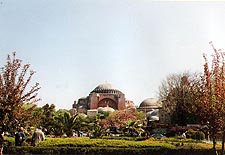Emperor Justinian I and Reform
By Justinian’s time most of the citizens of the Empire had accepted Christianity, but there were still some strong pockets of resistance to the Gospel. Justinian’s reign saw a concerted attack against the remnants of Hellenistic paganism in the empire. The University of Athens was closed in 529, and exclusively Christian learning and culture were promoted. Justinian also undertook a massive codification of the laws of the Empire, which became known as the Code of Justinian. In its introduction, the emperor made his own personal declaration of his faith in Christ.

Justinian built many church buildings in the imperial city and throughout the empire, particularly in Jerusalem and Bethlehem, and at Saint Catherine’s Monastery on Mount Sinai. His greatest creation was the temple in Constantinople dedicated to Christ the Wisdom of God—the magnificent Church of the Hagia Sophia, with the largest dome ever built, even to this day. Iconography, engraving, and mosaic work flourished during this time. The basilicas of Ravenna, with their famous mosaic iconographic frescoes, were built in this era (Ravenna, in northeastern Italy, would long be the main seat of Byzantine imperial authority in the West during this period of barbarian conquests).
